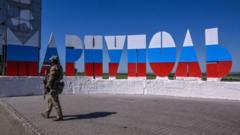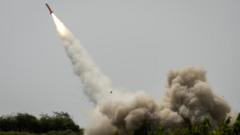The residents of Mariupol describe a city plagued by destruction, propaganda, and resistance amid its ongoing occupation by Russian forces.
**Voices from the Shadows: The Reality of Life in Occupied Mariupol**

**Voices from the Shadows: The Reality of Life in Occupied Mariupol**
Residents of Mariupol challenge Russia's narrative, revealing the harsh truths of living under occupation.
Despite Russian claims of reconstruction in Mariupol, locals paint a starkly different picture of their city. “What they show on Russian TV is fairy tales for fools,” says John, a resident who remains anonymous due to fear of reprisal from the authorities. The ruins of the besieged city, which fell to Russian forces over three years ago, remain prevalent. While Russian media highlights repaired facades along main streets, John notes that “around the corner, there is rubble and emptiness” and many inhabitants still live in damaged apartments.
The aftermath of the brutal siege has left Mariupol devastated, with the UN reporting that 90% of residential buildings suffered damage. Local accounts contradict the rosy image projected by pro-Russian influencers. Olha Onyshko, who escaped last year, shares her sorrow: “We had a beautiful city, but now it’s diseased.” She expresses disbelief over claims of reconstruction, highlighting that only the central square has seen any real work done, with bodies still buried in the rubble.
Critical resources are in short supply, with residents experiencing severe water shortages and power outages. James, another resident, describes their water as “yellow” and unfit for consumption, stating that the only water source has run dry. Furthermore, basic medicines are scarce, creating a dire situation for those requiring regular treatment.
Beyond basic necessities, the indoctrination of children poses a grave concern. Andrii Kozhushyna, having studied under occupation, expresses alarm over the propaganda in school curriculums which falsely teaches that various regions are now part of Russia. Teachers risk intimidation for refusing to deliver these lessons. The culture of control extends to military-style celebrations imposing Soviet traditions, prompting a wave of silent resistance.
Defiance exists in the shadows, as groups form resistance to counter the occupation. Members utilize covert methods to document Russian military movements and stage acts of sabotage. The resistance often passes on crucial intelligence to Ukrainian forces, despite the risks. James describes a culture of fear, with daily life marked by paranoia over surveillance and the potential for arrest.
The desire for liberation remains strong among the residents. Against a backdrop of discussions about territorial concessions for peace negotiations, they voice their determination against what they perceive as betrayal. “We want liberation, not ‘peace at any cost’,” declares John, capturing the resilient spirit of Mariupol’s inhabitants as they navigate life under the hardships of occupation.
The aftermath of the brutal siege has left Mariupol devastated, with the UN reporting that 90% of residential buildings suffered damage. Local accounts contradict the rosy image projected by pro-Russian influencers. Olha Onyshko, who escaped last year, shares her sorrow: “We had a beautiful city, but now it’s diseased.” She expresses disbelief over claims of reconstruction, highlighting that only the central square has seen any real work done, with bodies still buried in the rubble.
Critical resources are in short supply, with residents experiencing severe water shortages and power outages. James, another resident, describes their water as “yellow” and unfit for consumption, stating that the only water source has run dry. Furthermore, basic medicines are scarce, creating a dire situation for those requiring regular treatment.
Beyond basic necessities, the indoctrination of children poses a grave concern. Andrii Kozhushyna, having studied under occupation, expresses alarm over the propaganda in school curriculums which falsely teaches that various regions are now part of Russia. Teachers risk intimidation for refusing to deliver these lessons. The culture of control extends to military-style celebrations imposing Soviet traditions, prompting a wave of silent resistance.
Defiance exists in the shadows, as groups form resistance to counter the occupation. Members utilize covert methods to document Russian military movements and stage acts of sabotage. The resistance often passes on crucial intelligence to Ukrainian forces, despite the risks. James describes a culture of fear, with daily life marked by paranoia over surveillance and the potential for arrest.
The desire for liberation remains strong among the residents. Against a backdrop of discussions about territorial concessions for peace negotiations, they voice their determination against what they perceive as betrayal. “We want liberation, not ‘peace at any cost’,” declares John, capturing the resilient spirit of Mariupol’s inhabitants as they navigate life under the hardships of occupation.




















